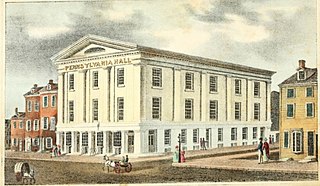 W
WThe Cincinnati riots of 1841 occurred after a long drought had created widespread unemployment in Cincinnati, Ohio, United States. Over a period of several days in September 1841, unemployed whites attacked black residents who defended themselves. Many blacks were rounded up and held behind a cordon and then moved to the jail. According to the authorities, this was for their own protection.
 W
WThe Lombard Street riot was a three-day race riot in Philadelphia, Pennsylvania, in 1842. The riot was the last in a 13-year period marked by frequent racial attacks in the city. It started on Lombard Street, between Fifth and Eighth streets.
 W
WElijah Parish Lovejoy was an American Presbyterian minister, journalist, newspaper editor, and abolitionist. He was shot and killed by a pro-slavery mob in Alton, Illinois, during their attack on the warehouse of Benjamin Godfrey and W. S. Gillman, where Lovejoy's press and abolitionist materials were stored.
 W
WThe Marais des Cygnes massacre is considered the last significant act of violence in Bleeding Kansas prior to the outbreak of the American Civil War. On May 19, 1858, approximately 30 men led by Charles Hamilton, a Georgian native and proslavery leader, crossed into the Kansas Territory from Missouri. They arrived at Trading Post, Kansas in the morning and then headed back to Missouri. Along the way they captured 11 Free-Staters, none of whom were armed and, it is said, none of whom had participated in the ongoing violence. Most of the men knew Hamilton and apparently did not realize he meant them harm. These prisoners were led into a defile, where Hamilton ordered the men to shoot. He even shot and fired the first bullet himself. Five men were killed and five severely wounded. Only one Free-Stater escaped injury.
 W
WPennsylvania Hall, "one of the most commodious and splendid buildings in the city," was an abolitionist venue in Philadelphia, Pennsylvania, built in 1837–38. It was a "Temple of Free Discussion", where antislavery, women's rights, and other reform lecturers could be heard. Four days after it opened it was destroyed by arson, the work of an anti-abolitionist mob. Except for the burning of the White House and the Capitol during the War of 1812, it was the worst case of arson in American history up to that date.
 W
WThe Sacking of Lawrence occurred on May 21, 1856, when proslavery settlers, led by Douglas County Sheriff Samuel J. Jones, attacked and ransacked Lawrence, Kansas, a town which had been founded by antislavery settlers from Massachusetts who were hoping to make Kansas a free state. The incident fueled the irregular conflict in Kansas Territory that later became known as Bleeding Kansas.
 W
WThe Snow Riot was a riot and lynch mob in Washington, D.C. in August 1835. An attack on free blacks in the city by whites, the Snow Riot wreaked havoc on anything affiliated with free blacks for days, destroying or damaging many of their establishments. The name of the riot comes from one of the first destinations the mob attacked, the restaurant owned by a free black man, Beverly Snow's Epicurean Eating House. After attacking the restaurant, the mob destroyed the school Arthur Bowen went to, because he was suspected of being taught the abolition of slavery there. The larger context of the attack on the school was the white working-class men's frustration over free blacks' ability to work, and their resentment of black competition for jobs. The clear result was the unleashing of white terror against blacks. The riot began on 12 August 1835 and continued for days in the nation's capital, and it was not until President Andrew Jackson intervened that it stopped.